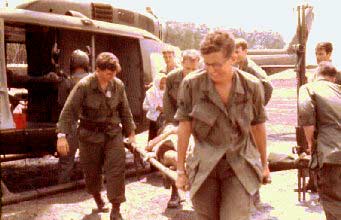|
|
||
| Lia Khe,
Headquarters of the 1st Infantry Division
The Dust Off mission was always a challenge when it came to emotional control. There were days of such elation because you had made a difference saving lives and escaping situations that seemed insurmountable. On days when we evacuated large numbers of wounded Americans it was a feeling of great satisfaction and at the same time terrible feelings of anger building to rage. The job of Dust Off crew member was one that required you to be calloused to the horrors and the reality you would face when mass casualties were in need of evacuation. On the 31st of Jan 1968
the Vietnam War had entered a critical stage as it shifted gears I still do not remember
the exact count of men we pulled out of that hell hole but I had a row
of five on the bottom and a second layer. There was at least one body
on top of the stack. What I will always remember was the pilot, Warrant
Officer John Vandivier, who after watching the loading yelled
,"man, look what they did to those boys!" The comment set of a
blinding flash of rage. I was beyond reason and only Mr. Talbot
yelling, coming up, and our duties of clearing the aircraft took over as
SP4 Telischak and I responded, "Ready right.","Ready
left." ,"Coming up." ,"Clear up left."
,"Clear up right." Dennis quickly applied a stack of 4x4's to the open wound and placed three four inch elastic ace wraps together, two down and one up as I taped them together. I placed them firmly on the 4x4's. Dennis then wrapped a six inch elastic ace wrap around the man sealing the wound with a perfect pressure dressing. After the wounds had been checked and properly dressed we gave him all the support we could. He just gazed out the door in shock, transfixed on nothing and he never looked at the carnage we were sitting on. When we dropped them all off at the 93rd
Evacuation Hospital in Long Binh, I carried the Lt. to a litter
waiting just off the pad and watched as he was rushed to the doors of
the Forgiveness is a powerful grace our Lord offers us. I choose to take Gods will for me and fought to live. I am sure the VC, Commander from February 1968 did not lose much sleep over executing American troops ... or did he? |
||
|
Dedicated to my friend Kenneth Ray Rucker, who died on a hoist mission on 27 May 1968 KENNETH RAY RUCKER Photo: Kenneth Ray Rucker
carries litter with wounded child to the aide station at Lai Khe a week
before his being killed in action. You can find KENNETH RUCKER
honored on the Vietnam Memorial Wall on Panel 65W, Row 14. LEWIS ARTHUR TRASK by Richard D. Cunnare I will always remember the friends I made in the service during the Vietnam War. LEWIS TRASK was born on May 28, 1947. He became a member of the Army while in Las Vegas, Nevada and attained the rank of PFC (E3). On October 6, 1967 at the age of 20, LEWIS TRASK gave his life in the service of our country in South Vietnam, Binh Duong Province. Lew was serving as a crew chief on a Dust Off aircraft from the 45 Medical Company, 4th Flight Platoon based out of Lai Khe, South Vietnam. The reflection of Lew focuses on how I remembered the scared insecure blustering kids going to war. My memory of coming over to Vietnam on the USNS, Kula Gulf , a converted WW11 jeep carrier had been full of unknowns about how I would react to combat and the need for me to ante up like a man. There were twenty-four of us from the 45th Medical Company, Air Ambulance who went by ship. The new 25 UH-IH, Huey helicopters that had been flown directly from the Bell Helicopter plant located in Fort Worth, Texas were already loaded on the flight deck. These were the first UH-1H helicopters issued to medical evacuation units and they were equipped with the L13 engine. The L-13 engine was a tremendous improvement for the Huey helicopter. It produced an additional 200 shaft horsepower and made the UH-1H a vast improvement over the existing UH-1D fleet . To my surprise the Pacific Ocean had been like a sheet of glass, absolutely calm. The calm had been a great help in steeling me for my future role as a Dust Off crew chief. This smooth as glass sea during our 21 day cruise from Oakland, California to the City of Vung Tau, Republic of Vietnam was unusual. I really enjoyed the voyage in spite of the boredom. We would spend hours engaged in long conversations about our families, friends and girl friends. Many times we would talk about what a tough job we would have getting the aircraft ready once we reached our port. The sea life was a spectacular part of the experience. Flying fish, Dauphins and Whales entertained us with performances that had been practiced in front of countless American fighting men on the way to war. The aircraft had their rotor systems disassembled and boxed in airtight containers. The Huey's had been cocooned in a white plastic coating that was sprayed on ensuring that they we airtight. The procedure was designed to protect the aircraft from the salt spray. A Huey helicopter is constructed out of the highest quality aluminum, magnesium and steal. All these metals are prone to corrode and great care had to be taken to protect the aircraft inside an airtight protective cover. Exposure to the salt air for a prolonged period of time would cause extensive corrosion damage and dramatically weaken the honeycomb structure, shorten the life of the aircraft and could lead to a catastrophic failure of the airframe. Our job when we arrived at the Port of Vung Tau would be to strip the protective plastic cocoons , reassemble the aircraft rotor systems, track the rotor systems and decontaminate the aircraft to prevent corrosion once they were flown to the Vung Tau air strip. A favorite shipmate of mine had been Lew Trask a fellow crew chief from Las Vegas, Nevada. We had spent most of our time together. Lew was about a year younger than I was but we shared many of the same passions for adventure and the same fears about what we were getting into with our service in Vietnam. Lew and I had met in the 45th Medical Company at Fort Bragg, North Carolina and we had palled around for a couple of months before we shipped out as we were assigned to the 4th platoon together. Just before, we had shipped out, Lew went home and married his high school sweat heart. I kept my personal feelings to myself as Lew was deeply in love with his bride and fully understood how it had changed his life. I felt marriage, for a man going into combat became a burden. My own personnel beliefs about becoming to cautious were it could make my adjustment harder and ultimately, more dangerous. Young men make commitments to serve their countries and many dream of glory and the great adventures waiting for them. Lew and I had fixed on the reality of why we had volunteered for flying as medical evacuation crew members. "Maybe", This step to maturity was essential to backing up our bravado with the commitment necessary to perform. The missions we were to perform in Vietnam, though humanitarian, were extremely dangerous. As crew chiefs we had extensive aviation training and experience back at Fort Bragg. Aero medical evacuation remains the most dangerous flying job in civilian aviation. When you add the stressors of combat and the bond soldiers have for each other the pressure is extreme. Our medical training had been more extensive than most aviation personal but nothing in our lives could put our future requirements properly into context. One of my biggest concerns was not only how I would perform in battle but also would I be able to help save the lives of critically wounded men. The big joke during our training and getting the unit up and ready for deployment from Fort Bragg was that we would not believe that we were going to be in combat until we heard the first bullet's cracking over head. The closer we got to Vietnam on our slow boat to the South China Sea the more reticent we had become. We had another company on the boat in the form of an advanced party for the 25 Army Bird Dog aircraft on the carrier. The Bird Dog O-1 was a single engine fixed wing aircraft that was used to spot as a forward air controller for Army Gun Ships, and adjust artillery fire. One of their men who was from Florida was part of our nightly discussions on the fantail of the ship. He had discussed his firm belief in the Bible and gave us his insights into Gods plan for our lives. Both Lew and I had been raised in the Catholic Church. Our new friend used Gods word, according to the King James Version of the Bible, as his absolute authority for spiritual guidance. This personal commitment of his, led to many spirited conversations and friendly banter of calling each other pagans. The conversations gave me a fresh look at Gods plan for my life because I had never really made a personal commitment to turning my life over to God. Those evenings had been the first time in my life that I had even considered any other doctrine other than what I had been trained to believe in the Catholic Church. We found that being scared was an honorable reaction. "I was scared" Rich Cunnare July 1967- "My attitude changed when I realized I was not the only one on the boat who was scared. Everyone else was scared also. I started asking guys, "Are you scared, too?" "You bet your sweet life I am, they all seemed to say at once." "Aha, so that's the way it is for you, too." We were all in the same situation. That's probably what was so beneficial about the time on the trip over. When I ask, "Who else feels like this?" The five other guys standing with us on the fantail who were also 19 and 20 year olds like us, all raised their hands. The guys realized they were not the only one who felt that way. It was a truly spiritual feeling and funny as hell. We all laughed until we cried as Lew put on his Winston Churchill act, standing with his hands on his hips his face puffed up and repeating" we have nothing to fear but fear itself"... That moment is still as clear as a fresh spring breeze in my mind as a link to manhood. The last evening we were on the boat Lew and I had become resigned to whatever God wanted for us and cemented a bond of eternal brotherhood. The youthful belief that it would happen to the other guy, it could not happen to us, was finally being replaced with serious doubts. The stark reality was that, we might not get home again. As a way to reassure ourselves we agreed to help each other and made a strange pact. Our agreement was based on our belief that if there was a life after death and that God would allow us to come back to be the guardian angel to our brothers still locked in combat. I have only the memories of my good friend Lew Trask. The loss had happened on the 6th of October 1967, during bad weather. The immense pressure for a crew to try to do just about anything to get the wounded evacuated was always extreme and had to be balanced by the reality of the situation. The crew of Dust Off 43 had been listening to the tactical radio all evening and constantly walking outside to check the weather. A unit of the 25th Infantry Division had wounded man from a mortar attack. The mission was sent in as urgent meaning the man was going to die without immediate evacuation to Dau Teing for surgery. The weather had everybody socked in as visibility was almost zero. Lt Robert Burlingham was a good pilot and a compassionate man who over rated his ability to fly instruments. His co-pilot Robert Porea was developing his skills as a helicopter pilot and had proven himself on many occasions to be excellent under pressure. The aircraft commander had communicated with one of our best pilots at Lai Khe..Warrant Officer David Talbot had fully understood the danger involved and advised that the mission was to risky and to wait till morning to attempt the rescue. At approximately 2000 hours (8:00 p.m.), Lt. Burlington approached the crew and in unison they all volunteered to fly the mission. In the finest traditions of army aviation with complete disregard for their safety they anted up like men. Each crew member knew that everything was stacked against them surviving. At approximately 2005 hours they took of from the Dau Tieng airfield and were enroute to the pick up zone. The weather was still so bad that it was like working their way toward the wounded soldier like a blind man feeling his way through a mine field with a hammer. The aircraft had been hovering slowly over the dense jungle. It was never known if the aircraft had been hit by ground fire or the crew had become disoriented and crashed. The crash occurred at approximately 2010 hours, by noon the next day the crash site had been secured and the bodies were recovered. Lew Trask had survived the crash as his horribly burned body was found about 50 meters from the aircraft. A clear trail could be seen from where Lew had crawled away from the crash with his body on fire. The was some evidence to support that Lew had survived the crash and gone back to rescue his friends when a secondary explosion engulfed him in flames. The other crew members had died on impact as their chard bodies were still strapped in their seats. These brave men went to their deaths by taking a mission to save the life of soldier completely unknown to them. The fiery crash had taken the lives of three other platoon members all friends, 1st Lt. Robert Gene Burlingham, Warrant Officer Robert George Porea and Medic Specialist Four Joseph Hoggat. The story of the event appeared on the front page of the New York Times under the title Dust Off's Down: Sub title, Four Hero's Die Fiery Deaths Trying to Save Their Comrades. Quote from story, "No greater love has any man than one who would lay down his life for his fellow man." It has been an honor in my life to have served with these awesome men. Men charged with making these difficult life and death decisions often make mistakes. Our friends asked for nothing and gave all they had while living up to a standard of performance often filled with great danger. It is in that spirit their memory lives in the minds eye of those who knew them. The perception of Dust Off crews willingness to fly missions under most circumstances was a great comfort to the soldiers fighting the terror of jungle warfare and disease. Ironically the advice Mr. Talbot had given Lt. Burlingham was just what should have been done as the wounded soldier survived the night and was evacuated the next morning. The wounded soldiers' survival could lead to the feeling that the crew died for no reason. The frustration, anger and rage suffered by men in battle is often carried throughout life. God's plan had been carried out for Lew Trask and the crew of Dust Off 43. As the Lord admitted these men to eternal glory, I have a vision of how they were showered with his praise. In my vision I hear the Lord saying, "Bob, Joseph, Lew, Robert I bless you for your sacrifice to the brotherhood of man, welcome home to eternal life brothers. There are some lessons which cannot be learned quickly, and time, which is all we have, must be paid heavily for their acquiring. They are the very simplest things and because it takes a man's life to know them the little new that each man gets from life is very costly and the only heritage he has to leave. The most important lesson I had learned there is no glory to war, none at all but the memories of our lost friends are so special that they should be never forgotten. If we as friends don't remember who will? You can find LEWIS TRASK honored on the Vietnam Memorial Wall on Panel 27E, Row 62. If you ever find yourself in Washington DC. Take the time to go see Lew and tell him what a great job he has done as my guardian angel. I am sure Lew would like to hear it. |
||
|
© War-Stories.com 1995-2023. All Rights Reserved.
|
||
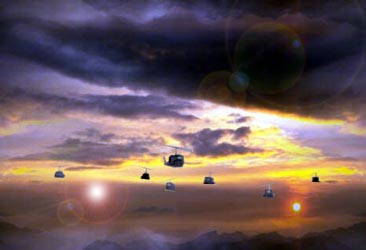
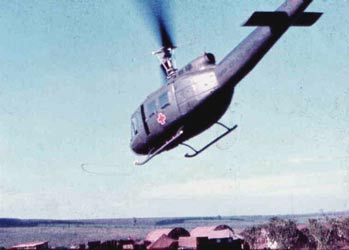 from the a cat and mouse gorilla war to full scale country wide attacks
on all installations and Provincial Cities. The losses were heavy and
the mission of medical evacuation helicopters had become electric
twenty-four hours a day. Our unit attitude of, "your wounded at all
cost", was costing us all we had.
from the a cat and mouse gorilla war to full scale country wide attacks
on all installations and Provincial Cities. The losses were heavy and
the mission of medical evacuation helicopters had become electric
twenty-four hours a day. Our unit attitude of, "your wounded at all
cost", was costing us all we had.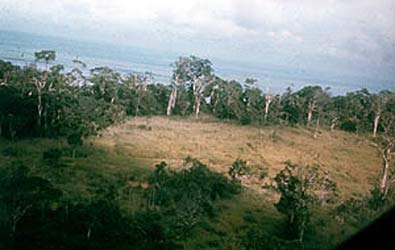 of the bravest men I have ever known. It was an honor to have flown with
such a man. Our bond to each other was reinforced by rituals at the
beginning of each combat approach, we would look each other in the eyes,
shake our heads, role our eyes while we would lock and load our M-16's.
Tunnel vision would then take over as we compacted ourselves into the smallest target possible and focused every sense
available to us on the approach.
of the bravest men I have ever known. It was an honor to have flown with
such a man. Our bond to each other was reinforced by rituals at the
beginning of each combat approach, we would look each other in the eyes,
shake our heads, role our eyes while we would lock and load our M-16's.
Tunnel vision would then take over as we compacted ourselves into the smallest target possible and focused every sense
available to us on the approach.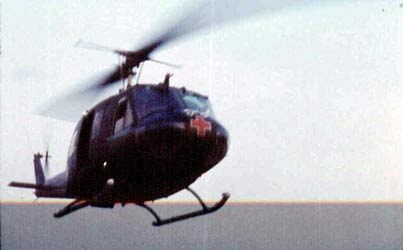 emergency triage room.
emergency triage room.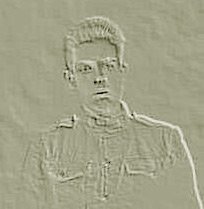 A few days before I was shot down. I had been cleared to fire on a
village south of Đà Nẵng in support of our Night Hawk who had taken heavy .51 cal fire. The
Army of South Vietnam fire coordinator flying with Night Hawk had issued
clearance to fire on the village. My wing man confirmed the clearance
and we compared the clearance initials. My fire was on target. The
result at the first light bomb damage assessment (BDA) by the Scouts
found 12 bodies in the burned out section of the south eastern part of
the village. Unfortunately not a military age body was found. Old men,
women and children were the only KIA's found.
A few days before I was shot down. I had been cleared to fire on a
village south of Đà Nẵng in support of our Night Hawk who had taken heavy .51 cal fire. The
Army of South Vietnam fire coordinator flying with Night Hawk had issued
clearance to fire on the village. My wing man confirmed the clearance
and we compared the clearance initials. My fire was on target. The
result at the first light bomb damage assessment (BDA) by the Scouts
found 12 bodies in the burned out section of the south eastern part of
the village. Unfortunately not a military age body was found. Old men,
women and children were the only KIA's found.